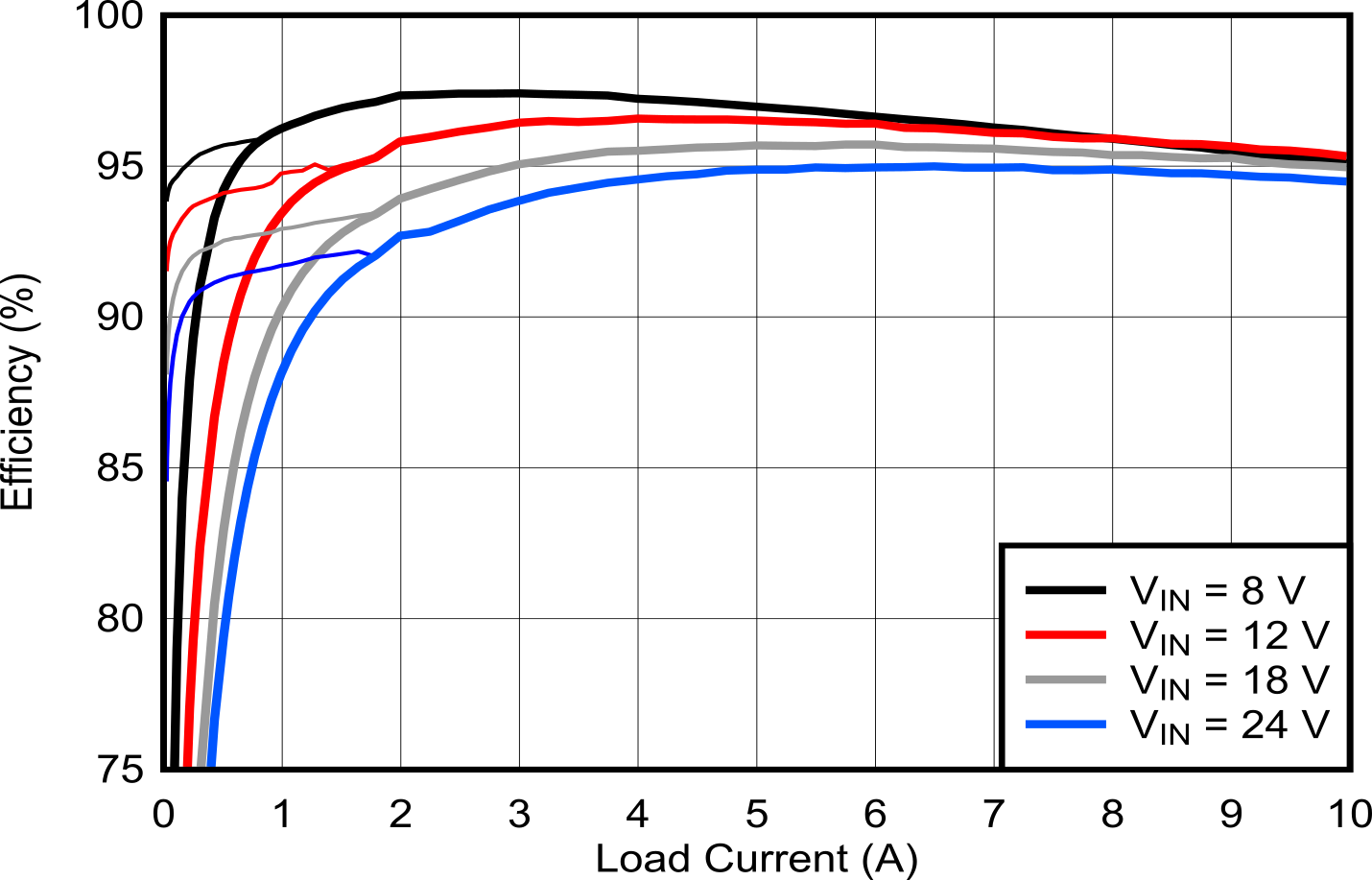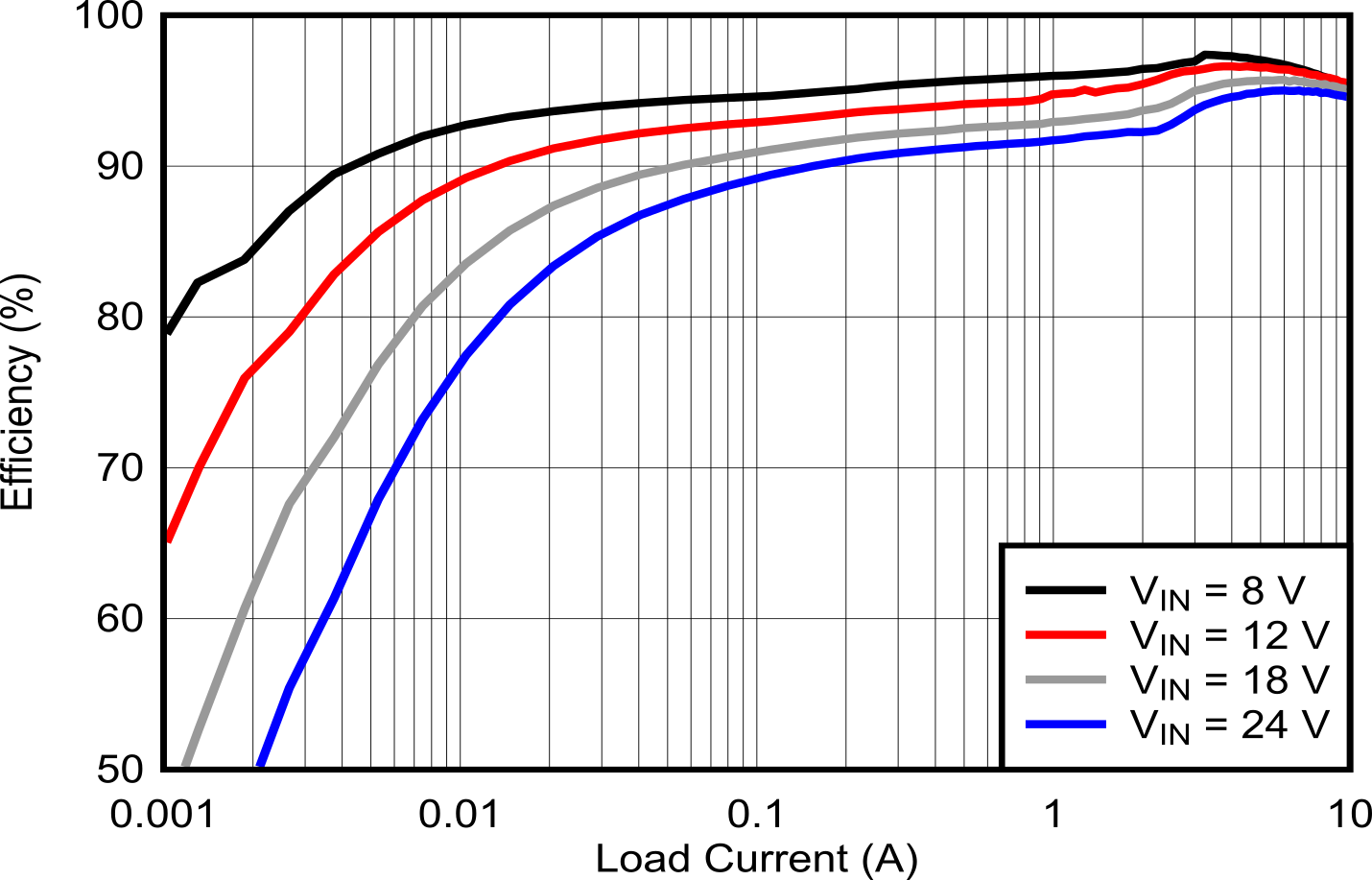SNVSBV5B December 2020 – December 2021 LM25149
PRODUCTION DATA
- 1 Features
- 2 Applications
- 3 Description
- 4 Revision History
- 5 Description (continued)
- 6 Pin Configuration and Functions
- 7 Specifications
-
8 Detailed Description
- 8.1 Overview
- 8.2 Functional Block Diagram
- 8.3
Feature Description
- 8.3.1 Input Voltage Range (VIN)
- 8.3.2 High-Voltage Bias Supply Regulator (VCC, VCCX, VDDA)
- 8.3.3 Precision Enable (EN)
- 8.3.4 Power-Good Monitor (PG)
- 8.3.5 Switching Frequency (RT)
- 8.3.6 Active EMI Filter
- 8.3.7 Dual Random Spread Spectrum (DRSS)
- 8.3.8 Soft Start
- 8.3.9 Output Voltage Setpoint (FB)
- 8.3.10 Minimum Controllable On Time
- 8.3.11 Error Amplifier and PWM Comparator (FB, EXTCOMP)
- 8.3.12 Slope Compensation
- 8.3.13 Inductor Current Sense (ISNS+, VOUT)
- 8.3.14 Hiccup Mode Current Limiting
- 8.3.15 High-Side and Low-Side Gate Drivers (HO, LO)
- 8.3.16 Output Configurations (CNFG)
- 8.3.17 Single-Output Dual-Phase Operation
- 8.4 Device Functional Modes
-
9 Application and Implementation
- 9.1 Application Information
- 9.2
Typical Applications
- 9.2.1
Design 1 – High Efficiency 2.1-MHz Synchronous
Buck Regulator
- 9.2.1.1 Design Requirements
- 9.2.1.2
Detailed Design Procedure
- 9.2.1.2.1 Custom Design With WEBENCH® Tools
- 9.2.1.2.2 Custom Design With Excel Quickstart Tool
- 9.2.1.2.3 Buck Inductor
- 9.2.1.2.4 Current-Sense Resistance
- 9.2.1.2.5 Output Capacitors
- 9.2.1.2.6 Input Capacitors
- 9.2.1.2.7 Frequency Set Resistor
- 9.2.1.2.8 Feedback Resistors
- 9.2.1.2.9 Compensation Components
- 9.2.1.2.10 Active EMI Components
- 9.2.1.3 Application Curves
- 9.2.2 Design 2 – High Efficiency 440-kHz Synchronous Buck Regulator
- 9.2.3 Design 3 – Dual-Phase 400-kHz 20-A Synchronous Buck Regulator
- 9.2.1
Design 1 – High Efficiency 2.1-MHz Synchronous
Buck Regulator
- 10Power Supply Recommendations
- 11Layout
- 12Device and Documentation Support
- 13Mechanical, Packaging, and Orderable Information
Package Options
Mechanical Data (Package|Pins)
- RGY|24
Thermal pad, mechanical data (Package|Pins)
- RGY|24
Orderable Information
7.7 Typical Characteristics

| VOUT = 5 V | FSW = 440 kHz |
| VEN = 0 V |
| VVOUT = 3.3 V | 1.03 V ≤ VEN ≤ 42 V |
Figure 7-7 Fixed 3.3-V
Output Voltage vs. Temperature
Figure 7-9 Feedback (FB) Voltage vs. Temperature
Figure 7-11 PG UV
Thresholds vs. Temperature
Figure 7-13 VCC UVLO
Thresholds vs. Temperature
Figure 7-15 VDDA Regulation
Voltage vs. Temperature
Figure 7-17 VCCX On/Off
Thresholds vs. Temperature
Figure 7-19 Current Sense
(CS) Amplifier Gain vs. Temperature
Figure 7-21 Soft-start Time
vs. Temperature

| VOUT = 5 V | FSW = 440 kHz |
| 0.5 V ≤ VEN ≤ 1 V |
| VVOUT = 5 V | 1.03 V ≤ VEN ≤ 42 V |
Figure 7-8 Fixed 5-V
Output Voltage vs. Temperature
Figure 7-10 PG OV
Thresholds vs. Temperature
Figure 7-12 VCC Regulation
Voltage vs. Temperature
Figure 7-14 VCC Current
Limit vs. Temperature
Figure 7-16 VDDA UVLO
Thresholds vs. Temperature
Figure 7-18 Current Sense
(CS) Threshold vs. Temperature
Figure 7-20 Minimum On Time
(HO) vs. Temperature
| RRT = 9.09 kΩ |